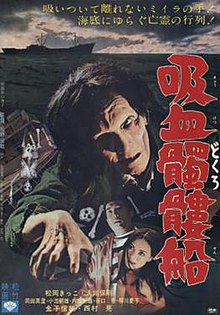| The Living Skeleton | |
|---|---|
 Theatrical release poster Theatrical release poster | |
| Directed by | Hiroshi Matsuno |
| Written by |
|
| Produced by | Akira Inomata |
| Starring |
|
| Cinematography | Masayuki Katō |
| Edited by | Kazuo Ōta |
| Music by | Noboru Nishiyama |
| Production company | Shochiku |
| Release date |
|
| Running time | 80 minutes |
| Country | Japan |
| Language | Japanese |
The Living Skeleton (吸血髑髏船, Kyūketsu Dokurosen) is a 1968 Japanese horror film directed by Hiroshi Matsuno.
Plot
The film begins in the past where a gang of pirates commandeer a ship and kill everyone on board. Three years later in a seaside village, a Catholic priest (Masumi Okada) has offered shelter to Saeko (Kikko Matsuoka) as her twin sister, Yoriko (also Matsuoka) has disappeared with her new husband at sea. Saeko later scuba dives with her boyfriend, the couple find a group of submerged human skeletons, chained together at the ankles near the ocean floor. That night, a ghost ship appears in the mist offshore as a voice from the ship calls out for Saeko.
Production
Director Hiroshi Matsuno began working at the film production company Shochiku in 1950 and worked as an assistant director for filmmakers such as Daisuke Itō, Mikio Naruse, and Yoshitarō Nomura. Matsuno directed a few films starring Bunta Sugawara in the early sixties before working on The Living Skeleton. The Living Skeleton was co-written by Kikuma Shimoiizaka, a prolific mystery novelist in Japan.
Release
The Living Skeleton was released on November 9, 1968 in Japan. It was released as a double feature with Genocide.
It was released on DVD by the Criterion Collection in a box set on November 20, 2012. The other films in the box set included The X from Outer Space, Goké, Body Snatcher from Hell, and Genocide.
Reception
Slant Magazine referred to The Living Skeleton as "representing the peak of Shochiku's dalliance with horror convention" and a "chilling and genuinely unnerving black-and-white update of the bygone kaidan tradition". The Austin Chronicle referred to the film as "probably the most conventional of Schochiku's [sic] horror releases"
Professor Wheeler Winston Dixon of the University of Nebraska–Lincoln referred to the Criterion Collection's Eclipse set, calling the film "the most accomplished and sophisticated of the quartet in terms of its visual structure and narrative" and along with Genocide, "easily the most interesting entries".
See also
References
Footnotes
- ^ Stephens, Chuck (November 20, 2012). "Eclipse Series 37: When Horror Came to Shochiku". Criterion Collection. Retrieved July 17, 2013.
- Galbraith IV 1996, p. 467.
- Galbraith IV 1994, p. 320.
- Galbraith IV 1994, p. 321.
- "The Living Skeleton (1968) - Releases". Allmovie. Rovi Corporation. Archived from the original on August 28, 2016. Retrieved June 6, 2024.
- "Eclipse Series 37: When Horror Came to Shochiku". Criterion Collection. Retrieved July 17, 2013.
- Cronk, Jordan (January 2, 2013). "Eclipse Series 37: When Horror Came to Shochiku". Slant Magazine. Retrieved July 17, 2013.
- Whittaker, Richard (December 18, 2012). "DVD Watch: When Horror Came to Shochiku". Austin Chronicle. Retrieved July 17, 2013.
- Wheeler Winston Dixon, Ryan. "Eclipse Series 37: When Horror Came to Shochiku". University of Nebraska–Lincoln. Retrieved July 17, 2013.
Sources
- Galbraith IV, Stuart (1994). Japanese Science Fiction, Fantasy and Horror Films. McFarland. ISBN 0-89950-853-7.
- Galbraith IV, Stuart (1996). The Japanese Filmography: 1900 through 1994. McFarland. ISBN 0-7864-0032-3.